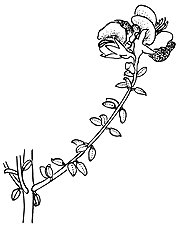Common name: Mountain Oxylobium
Oxylobium oxylobioides (F.Muell.) Crisp & R.L.Barrett APNI* Synonyms: Mirbelia oxylobioides F.Muell. APNI*

Description: Decumbent or erect shrub to 1.5 m high; stems terete, appressed-pubescent.
Leaves opposite, whorled or scattered, narrow-ovate to elliptic, occasionally oblong 2–10 mm long, 1–3 mm wide, apex with a minute recurved point, margins recurved, lower surface appressed-pubescent.
Flowers in few-flowered terminal racemes, shortly pedicellate. Calyx 5–6 mm long, silky-pubescent, teeth equal to tube. Corolla 8–10 mm long, orange-yellow and red; keel rusty or purplish red, ± equal to wings. Ovary shortly stipitate, pubescent; ovules 10 or more.
Pod ovoid to oblong, 8–10 mm long, apex acute, hairy.
Flowering: summer.
Distribution and occurrence: Chiefly at higher altitudes south from Wingello, also at Mt Kaputar N.P. and Mt Conobolas. Grows in dry sclerophyll forest.
NSW subdivisions: SC, NT, CT, ST, NWS, SWS
Other Australian states: Vic. Tas.
There are two morphotypes, particularly distinct in their pod indumentum, and recognition of a second taxon may be justified. The two morphotypes are know to co-occur in some location on the Southern Tablelands.
Text by M. F. Porteners, updated by R.L. Barrett, Aug. 2021
Taxon concept: Flora of NSW 2 (1991)
APNI* Provides a link to the Australian Plant Name Index (hosted by the Australian National Botanic Gardens) for comprehensive bibliographic data
***The AVH map option provides a detailed interactive Australia wide distribution map drawn from collections held by all major Australian herbaria participating in the Australian Virtual Herbarium project.
|


